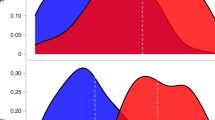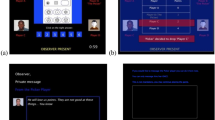Abstract
What predicts people’s powerful and universal dislike of social deviancy? Across six studies, aversion towards non-social pattern deviancy, for example, a row of triangles with one triangle out of line, predicted aversion towards stigmatized individuals, social norm breakers, statistically negative and positive deviants, and a racial minority group (Black individuals). The relationship between pattern deviancy and social deviancy aversion emerged across explicit and implicit measures, across cultures (United States and China), and was of a moderately large magnitude (meta-analytic effect size: d = 0.68). Studies 7 and 8 examined developmental differences. Older but not younger children’s pattern deviancy aversion related to their dislike of social norm breakers. Although non-social pattern deviancy and social deviancy judgements may seem distinct given their differing domains, people’s aversion towards non-social pattern deviancy and social deviancy consistently overlapped. These findings raise the possibility that pattern deviancy aversion plays an important role in stigmatization and prejudice.
This is a preview of subscription content, access via your institution
Access options
Access Nature and 54 other Nature Portfolio journals
Get Nature+, our best-value online-access subscription
$29.99 / 30 days
cancel any time
Subscribe to this journal
Receive 12 digital issues and online access to articles
$119.00 per year
only $9.92 per issue
Buy this article
- Purchase on Springer Link
- Instant access to full article PDF
Prices may be subject to local taxes which are calculated during checkout


Similar content being viewed by others
Change history
10 December 2020
A Correction to this paper has been published: https://doi.org/10.1038/s41562-020-01028-x.
References
Stangor, C. & Crandall, C. S. in The Social Psychology of Stigma (eds Heatherton, T. F., Kleck, R. E., Hebl, M. R. & Hull, J. G.) 62–87 (Guilford Press, New York, NY, 2000).
Neuberg, S. L., Smith, D. M. & Asher, T. in The Social Psychology of Stigma (eds Heatherton, T. F., Kleck, R. E., Hebl, M. R. & Hull, J. G.) 31–61 (Guilford Press, New York, NY, 2000).
Goffman, E. Stigma: Notes on the Management of Spoiled Identity (Simon and Schuster, New York, NY, 1963).
Major, B. & O’Brien, L. T. The social psychology of stigma. Annu. Rev. Psychol. 56, 393–421 (2005).
Durkheim, E. The Rules of the Sociological Method (The Free Press, New York, NY, 1985).
Katz, I. & Hass, G. R. Racial ambivalence and American value conflict: correlational and priming studies of dual cognitive structures. J. Pers. Soc. Psychol. 55, 893–905 (1988).
Allport, G. W. The Nature of Prejudice (Basic Books, New York, NY, 1979).
Trainor, L. J. & Heinmiller, B. M. The development of evaluative responses to music: infants prefer to listen to consonance over dissonance. Infant Behav. Dev. 21, 77–88 (1998).
Bornstein, M. H., Ferdinandsen, K. & Gross, C. G. Perception of symmetry in infancy. Dev. Psychol. 23, 82–86 (1981).
Dunham, Y., Baron, A. S. & Banaji, M. R. The development of implicit intergroup cognition. Trends Cogn. Sci. 12, 248–253 (2008).
Bigler, R. S. & Liben, L. S. A developmental intergroup theory of social stereotypes and prejudice. Adv. Child Dev. Behav. 34, 39–89 (2006).
Hardecker, S., Schmidt, M. F., Roden, M. & Tomasello, M. Young children’s behavioral and emotional responses to different social norm violations. J. Exp. Child Psychol. 150, 364–379 (2016).
Tomasello, M. & Vaish, A. Origins of human cooperation and morality. Annu. Rev. Psychol. 64, 231–255 (2013).
Sigelman, C. K., Miller, T. E. & Whitworth, L. A. The early development of stigmatizing reactions to physical differences. J. Appl. Dev. Psychol. 7, 17–32 (1986).
Weiss, M. F. Children’s attitudes toward the mentally ill: a developmental analysis. Psychol. Rep. 58, 11–20 (1986).
Farkas, A. Prototypicality-effect in surrealist paintings. Empir. Stud. Arts 20, 127–136 (2002).
Whitfield, T. A. & Slatter, P. E. The effects of categorization and prototypicality on aesthetic choice in a furniture selection task. Brit. J. Psychol. 70, 65–75 (1979).
Rhodes, G. The evolutionary psychology of facial beauty. Annu. Rev. Psychol. 57, 199–226 (2006).
Langlois, J. H. & Roggman, L. A. Attractive faces are only average. Psychol. Sci. 1, 115–121 (1990).
Bomba, P. C. & Siqueland, E. R. The nature and structure of infant form categories. J. Exp. Child Psychol. 35, 294–328 (1983).
Rubenstein, A. J., Kalakanis, L. & Langlois, J. H. Infant preferences for attractive faces: a cognitive explanation. Dev. Psychol. 35, 848–855 (1999).
Spitzer, A. & Cameron, C. School-age children’s perceptions of mental illness. Western J. Nurs. Res. 17, 398–415 (1995).
Okimoto, T. & Gromet, D. Differences in sensitivity to deviance partly explain ideological divides in social policy support. J. Pers. Soc. Psychol. 111, 98–117 (2016).
Fisher, J. The memory process and certain psychosocial attitudes, with special reference to the law of Pragnanz. J. Pers. 19, 406–420 (1951).
Roets, A. & Van Hiel, A. Allport’s prejudiced personality today: need for closure as the motivated cognitive basis of prejudice. Curr. Dir. Psychol. Sci. 20, 349–354 (2011).
Webster, D. M. & Kruglanski, A. Individual differences in need for cognitive closure. J. Pers. Soc. Psychol. 67, 1049–1062 (1994).
McCrae, R. R. & John, O. P. An introduction to the five‐factor model and its applications. J. Personal. 60, 175–215 (1992).
Altemeyer, B. The other “authoritarian personality”. Adv. Exp. Soc. Psychol. 30, 47–92 (1998).
Carver, C. S. & White, T. L. Behavioral inhibition, behavioral activation, and affective responses to impending reward and punishment: the BIS/BAS scales. J. Pers. Soc. Psychol. 67, 319–333 (1994).
Budner, S. Intolerance of ambiguity as a personality variable. J. Personal. 30, 29–50 (1962).
Greenwald, A. G., McGhee, D. E. & Schwartz, J. L. K. Measuring individual differences in implicit cognition: the implicit association test. J. Pers. Soc. Psychol. 74, 1464–1480 (1998).
Fazio, R. H. & Olson, M. A. Implicit measures in social cognition research: their meaning and use. Annu. Rev. Psychol. 54, 297–327 (2003).
Triandis, H. in Personality, Cognition and Values: Cross-cultural Perspectives of Childhood and Adolescence (eds Bagley, C. & Verma, G.K.) 60–95 (Macmillan, London, 1988).
Nisbett, R. E., Peng, K., Choi, I. & Norenzayan, A. Culture and systems of thought: holistic versus analytic cognition. Psychol. Rev. 108, 291–310 (2001).
Schmidt, M. F., Butler, L. P., Heinz, J. & Tomasello, M. Young children see a single action and infer a social norm promiscuous normativity in 3-year-olds. Psychol. Sci. 27, 1360–1370 (2016).
Coie, J. D. & Pennington, B. F. Children’s perceptions of deviance and disorder. Child Dev. 47, 407–413 (1976).
Kalish, C. W. Children’s predictions of consistency in people’s actions. Cognition 84, 237–265 (2002).
Ruble, D. N. & Dweck, C. S. Social Development. Review of Personality and Social Psychology (ed. Eisenberg, N.) 109–139 (Sage Publications, Thousand Oaks, CA, 1995).
Baillargeon, R. et al. in APA Handbook of Personality and Social Psychology: Vol. 1. Attitudes and Social Cognition (eds Mikulincer, M., Shaver, P. R., Borgida, E. & Bargh, J. A.) 79–150 (American Psychological Association, Wahsington DC, 2015).
Kurzban, R. & Leary, M. R. Evolutionary origins of stigmatization: the functions of social exclusion. Psychol. Bull. 127, 187–208 (2001).
Schaller, M. & Neuberg, S. L. in Advances in Experimental Social Psychology (eds Olson, J. & Zanna, M. P.) 1–55 (Academic Press, Burlington, VT, 2012).
Whitley, B. E. Jr Right-wing authoritarianism, social dominance orientation, and prejudice. J. Pers. Soc. Psychol. 77, 126–134 (1999).
Neuberg, S. L. & Newsom, J. T. Personal need for structure: individual differences in the desire for simpler structure. J. Pers. Soc. Psychol. 65, 113–131 (1993).
Eisenberger, N. I., Jarcho, J. M., Lieberman, M. D. & Naliboff, B. D. An experimental study of shared sensitivity to physical pain and social rejection. Pain 126, 132–138 (2006).
Williams, L. E. & Bargh, J. A. Experiencing physical warmth promotes interpersonal warmth. Science 322, 606–607 (2008).
Inagaki, T. K. & Eisenberger, N. I. Shared neural mechanisms underlying social warmth and physical warmth. Psychol. Sci. 24, 2272–2280 (2013).
Eisenberger, N. I. & Lieberman, M. D. Why rejection hurts: a common neural alarm system for physical and social pain. Trends Cogn. Sci. 8, 294–300 (2004).
Williams, L. E., Huang, J. Y. & Bargh, J. A. The scaffolded mind: higher mental processes are grounded in early experience of the physical world. Eur. J. Soc. Psychol. 39, 1257–1267 (2009).
Reber, R., Winkielman, P. & Schwarz, N. Effects of perceptual fluency on affective judgments. Psychol. Sci. 9, 45–48 (1998).
Olson, J. M., Roese, N. J. & Zanna, M. P. in Social Psychology: Handbook of Basic Principles (eds Higgins E. T. & Kruglanski A. W.) 211–238 (Guilford Press, New York, NY, 1996).
Nelson, T. D. Handbook of Prejudice, Stereotyping, and Discrimination (Psychology Press, New York, NY, 2009).
Corrigan, P. W. et al. Challenging two mental illness stigmas: personal responsibility and dangerousness. Schizophr. Bull. 28, 293–309 (2002).
Fiske, S. T., Cuddy, A. J., Glick, P. & Xu, J. A model of (often mixed) stereotype content: competence and warmth respectively follow from perceived status and competition. J. Pers. Soc. Psychol. 82, 878–902 (2002).
Rammstedt., B. & John, O. P. Measuring personality in one minute or less: a 10-item short version of the Big Five Inventory in English and German. J. Res. Pers. 41, 203–212 (2007).
Posner, M. I. Cognition: An Introduction (Scott, Foresman, Glenview, IL, 1973).
Näätänen, R. et al. Attention and mismatch negativity. Psychophysiology 30, 436–450 (1993).
Greenwald, A. G., Nosek, B. A. & Banaji, M. R. Understanding and using the implicit association test: I. An improved scoring algorithm. J. Pers. Soc. Psychol. 85, 197–216 (2003).
Henry, P. J. & Sears, D. O. The symbolic racism 2000 scale. Polit. Psychol. 23, 253–283 (2002).
Rosenthal, R. The file drawer problem and tolerance for null results. Psychol. Bull. 86, 638–641 (1979).
Borenstein, M., Hedges, L. V., Higgins, J. & Rothstein, H. R. A basic introduction to fixed‐effect and random‐effects models for meta‐analysis. Res. Synth. Methods 1, 97–111 (2010).
Goh, J. X., Hall, J. A. & Rosenthal, R. Mini meta‐analysis of your own studies: some arguments on why and a primer on how. Soc. Personal. Psychol. Compass 10, 535–549 (2016).
Blakemore, J. E. O. Children’s beliefs about violating gender norms: boys shouldn’t look like girls, and girls shouldn’t act like boys. Sex Roles 48, 411–419 (2003).
Carter, D. B. & Patterson, C. J. Sex roles as social conventions: the development of children’s conceptions of sex-role stereotypes. Dev. Psychol. 18, 812–824 (1982).
Weinraub, M. et al. The development of sex role stereotypes in the third year: relationships to gender labeling, gender identity, sex-types toy preference, and family characteristics. Child Dev. 55, 1493–1503 (1984).
Falk, G. Stigma: How We Treat Outsiders (Prometheus Books, Amherst, NY, 2001).
Rhodes, M. & Chalik, L. Social categories as markers of intrinsic interpersonal obligations. Psychol. Sci. 24, 999–1007 (2013).
Acknowledgements
The authors thank G. Oettingen, P. M. Gollwitzer, J. A. Richeson, S. W. C. Chang, A. Osorio Pizarro and the members of the Automaticity in Cognition, Motivation, and Evaluation Lab for their generous feedback on this research and paper. No funders had any role in study design, data collection and analysis, decision to publish or preparation of the manuscript.
Author information
Authors and Affiliations
Contributions
A.G. developed the study concept and design. Testing and data collection were performed by A.G., J.M. and Y.W. under the supervision of J.A.B. A.G. completed the data analysis and interpretation. A.G. and J.M. drafted the paper and J.A.B. provided critical revisions. All authors approved the final version of the paper for submission.
Corresponding author
Ethics declarations
Competing interests
The authors declare no competing interests.
Additional information
Publisher’s note: Springer Nature remains neutral with regard to jurisdictional claims in published maps and institutional affiliations.
Electronic supplementary material
Supplementary Information
Supplementary Notes, Supplementary Methods, Supplementary References
Rights and permissions
About this article
Cite this article
Gollwitzer, A., Marshall, J., Wang, Y. et al. Relating pattern deviancy aversion to stigma and prejudice. Nat Hum Behav 1, 920–927 (2017). https://doi.org/10.1038/s41562-017-0243-x
Received:
Accepted:
Published:
Issue Date:
DOI: https://doi.org/10.1038/s41562-017-0243-x
This article is cited by
-
Who Do I (Dis)Trust and Monitor for Ethical Misconduct? Status, Power, and the Structural Paradox
Journal of Business Ethics (2023)
-
Human aversion to differentness
Nature Human Behaviour (2017)



